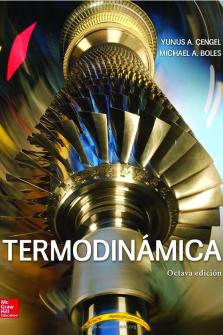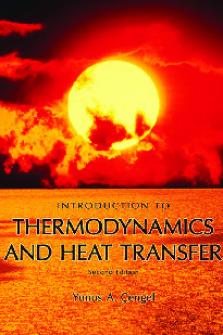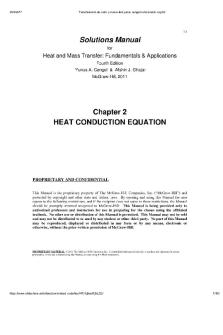Solucionario Yunus A. Cengel Michael A. Boles termodinámica 8 ED[0568-0685] PDF
![Solucionario Yunus A. Cengel Michael A. Boles termodinámica 8 ED[0568-0685]](https://pdfedu.com/img/crop/300x450/1n2jgqo65z2q.jpg)
| Title | Solucionario Yunus A. Cengel Michael A. Boles termodinámica 8 ED[0568-0685] |
|---|---|
| Author | reynaldo gonzales |
| Course | Tecnologia del gas |
| Institution | Escuela Militar de Ingeniería |
| Pages | 118 |
| File Size | 3 MB |
| File Type | |
| Total Downloads | 115 |
| Total Views | 178 |
Summary
libros de avance practico de ingenieria de gas y petroleo...
Description
7-1
Solutions Manual for
Thermodynamics: An Engineering Approach 8th Edition Yunus A. Çengel, Michael A. Boles McGraw-Hill, 2015
Chapter 7 ENTROPY
PROPRIETARY AND CONFIDENTIAL This Manual is the proprietary property of McGraw-Hill Education and protected by copyright and other state and federal laws. By opening and using this Manual the user agrees to the following restrictions, and if the recipient does not agree to these restrictions, the Manual should be promptly returned unopened to McGraw-Hill Education: This Manual is being provided only to authorized professors and instructors for use in preparing for the classes using the affiliated textbook. No other use or distribution of this Manual is permitted. This Manual may not be sold and may not be distributed to or used by any student or other third party. No part of this Manual may be reproduced, displayed or distributed in any form or by any means, electronic or otherwise, without the prior written permission of McGraw-Hill Education.
PROPRIETARY MATERIAL. © 2015 McGraw-Hill Education. Limited distribution permitted only to teachers and educators for course preparation. If you are a student using this Manual, you are using it without permission.
7-2
Entropy and the Increase of Entropy Principle
7-1C Yes. Because we used the relation ( QH/TH) = (QL/TL) in the proof, which is the defining relation of absolute temperature.
7-2C No. A system may reject more (or less) heat than it receives during a cycle. The steam in a steam power plant, for example, receives more heat than it rejects during a cycle.
7-3C Yes.
7-4C That integral should be performed along a reversible path to determine the entropy change.
7-5C No. An isothermal process can be irreversible. Example: A system that involves paddle-wheel work while losing an equivalent amount of heat.
7-6C The value of this integral is always larger for reversible processes.
7-7C No. Because the entropy of the surrounding air increases even more during that process, making the total entropy change positive.
7-8C If the system undergoes a reversible process, the entropy of the system cannot change without a heat transfer. Otherwise, the entropy must increase since there are no offsetting entropy changes associated with reservoirs exchanging heat with the system.
7-9C The claim that work will not change the entropy of a fluid passing through an adiabatic steady-flow system with a single inlet and outlet is true only if the process is also reversible. Since no real process is reversible, there will be an entropy increase in the fluid during the adiabatic process in devices such as pumps, compressors, and turbines.
7-10C Sometimes.
7-11C Never.
PROPRIETARY MATERIAL. © 2015 McGraw-Hill Education. Limited distribution permitted only to teachers and educators for course preparation. If you are a student using this Manual, you are using it without permission.
7-3
7-12C Always.
7-13C Increase.
7-14C Increases.
7-15C Decreases.
7-16C Sometimes.
7-17C Greater than.
7-18C They are heat transfer, irreversibilities, and entropy transport with mass.
7-19E The source and sink temperatures and the entropy change of the sink for a completely reversible heat engine are given. The entropy decrease of the source and the amount of heat transfer from the source are to be determined. Assumptions The heat engine operates steadily. Analysis According to the increase in entropy principle, the entropy change of the source must be equal and opposite to that of the sink. Hence,
TH QH
S H S L 10 Btu/R Applying the definition of the entropy to the source gives
QH TH S H (1500 R)( 10 Btu/R) 15,000Btu
HE Wnet
QL TL
which is the heat transfer with respect to the source, not the device.
PROPRIETARY MATERIAL. © 2015 McGraw-Hill Education. Limited distribution permitted only to teachers and educators for course preparation. If you are a student using this Manual, you are using it without permission.
7-4
7-20 Air is compressed steadily by a compressor. The air temperature is maintained constant by heat rejection to the surroundings. The rate of entropy change of air is to be determined. Assumptions 1 This is a steady-flow process since there is no change with time. 2 Kinetic and potential energy changes are negligible. 3 Air is an ideal gas. 4 The process involves no internal irreversibilities such as friction, and thus it is an isothermal, internally reversible process. Properties Noting that h = h(T) for ideal gases, we have h1 = h2 since T1 = T2 = 25C. Analysis We take the compressor as the system. Noting that the enthalpy of air remains constant, the energy balance for this steady-flow system can be expressed in the rate form as
E E out in
Rate of n etenergy transfer by heat, work,and mass
E system
0 (steady)
0
Rate of changein internal,kin etic, po tential,etc.energies
E in E out W in Q out
P2 · Q AIR T = const.
15 kW
Therefore,
W 15 kW Q out in Noting that the process is assumed to be an isothermal and internally reversible process, the rate of entropy change of air is determined to be
S air
Q out,air Tsy s
P1
15 kW 0.0503 kW/K 298 K
7-21 Heat is transferred directly from an energy-source reservoir to an energy-sink. The entropy change of the two reservoirs is to be calculated and it is to be determined if the increase of entropy principle is satisfied. Assumptions The reservoirs operate steadily. Analysis The entropy change of the source and sink is given by
S
QH QL 100 kJ 100 kJ 0.0833 kJ/K TH T L 1200 K 600 K
Since the entropy of everything involved in this process has increased, this transfer of heat is possible.
1200 K
100 kJ
600 K
PROPRIETARY MATERIAL. © 2015 McGraw-Hill Education. Limited distribution permitted only to teachers and educators for course preparation. If you are a student using this Manual, you are using it without permission.
7-5
7-22 It is assumed that heat is transferred from a cold reservoir to the hot reservoir contrary to the Clausius statement of the second law. It is to be proven that this violates the increase in entropy principle. Assumptions The reservoirs operate steadily. Analysis According to the definition of the entropy, the entropy change of the high-temperature reservoir shown below is
S H
100 kJ Q 0.08333 kJ/K TH 1200 K
TH Q =100 kJ
and the entropy change of the low-temperature reservoir is
S L
Q 100 kJ 0.1667 kJ/K 600 K TL
TL
The total entropy change of everything involved with this system is then
Stotal S H S L 0.08333 0.1667 0.0833kJ/K which violates the increase in entropy principle since the total entropy change is negative.
7-23 A reversible heat pump with specified reservoir temperatures is considered. The entropy change of two reservoirs is to be calculated and it is to be determined if this heat pump satisfies the increase in entropy principle. Assumptions The heat pump operates steadily. Analysis Since the heat pump is completely reversible, the combination of the coefficient of performance expression, first Law, and thermodynamic temperature scale gives
COPHP,rev
1 1 17.47 1 TL / TH 1 (280 K ) /(297 K)
The power required to drive this heat pump, according to the coefficient of performance, is then
W net,in
24°C 300 kW HP
W net
Q L 7°C
Q H 300 kW 17.17 kW COPHP,rev 17.47
According to the first law, the rate at which heat is removed from the low-temperature energy reservoir is
Q W Q L H net,in 300 kW 17.17 kW 282.8 kW The rate at which the entropy of the high temperature reservoir changes, according to the definition of the entropy, is
300 kW Q S H H 1.01kW/K TH 297 K and that of the low-temperature reservoir is
Q 17.17 kW S L L 1.01kW/K 280 K TL The net rate of entropy change of everything in this system is
S total SH S L 1.01 1.01 0 kW/K as it must be since the heat pump is completely reversible.
PROPRIETARY MATERIAL. © 2015 McGraw-Hill Education. Limited distribution permitted only to teachers and educators for course preparation. If you are a student using this Manual, you are using it without permission.
7-6
7-24 Heat is transferred isothermally from a source to the working fluid of a Carnot engine. The entropy change of the working fluid, the entropy change of the source, and the total entropy change during this process are to be determined. Analysis (a) This is a reversible isothermal process, and the entropy change during such a process is given by
S
Q T
Noting that heat transferred from the source is equal to the heat transferred to the working fluid, the entropy changes of the fluid and of the source become
S flu id
(b)
Qflu id Qin,flu id 900 kJ 1.337 kJ/K Tflu id Tflu id 673 K
Qou t,so urce 900 kJ Q S so urce so urce 1.337 kJ/K Tso urce Tso urce 673 K
Source 400C 900 kJ
(c) Thus the total entropy change of the process is
Sgen Stotal Sfluid Ssource 1.337 1.337 0
PROPRIETARY MATERIAL. © 2015 McGraw-Hill Education. Limited distribution permitted only to teachers and educators for course preparation. If you are a student using this Manual, you are using it without permission.
7-7
7-25 Problem 7-24 is reconsidered. The effects of the varying the heat transferred to the working fluid and the source temperature on the entropy change of the working fluid, the entropy change of the source, and the total entropy change for the process as the source temperature varies from 100°C to 1000°C are to be investigated. The entropy changes of the source and of the working fluid are to be plotted against the source temperature for heat transfer amounts of 500 kJ, 900 kJ, and1300 kJ. Analysis The problem is solved using EES, and the results are tabulated and plotted below. "Knowns:" {T_H = 400 [C]} Q_H = 1300 [kJ] T_Sys = T_H "Analysis: (a) & (b) This is a reversible isothermal process, and the entropy change during such a process is given by DELTAS = Q/T" "Noting that heat transferred from the source is equal to the heat transferred to the working fluid, the entropy changes of the fluid and of the source become " DELTAS_source = -Q_H/(T_H+273) DELTAS_fluid = +Q_H/(T_Sys+273) "(c) entropy generation for the process:" S_gen = DELTAS_source + DELTAS_fluid Sfluid [kJ/K] 3.485 2.748 2.269 1.932 1.682 1.489 1.336 1.212 1.108 1.021
Ssource [kJ/K] -3.485 -2.748 -2.269 -1.932 -1.682 -1.489 -1.336 -1.212 -1.108 -1.021
Sgen [kJ/K] 0 0 0 0 0 0 0 0 0 0
TH [C] 100 200 300 400 500 600 700 800 900 1000
4
S fluid [KJ/K]
3.5
Ssource = -Sfluid
3 2.5 QH = 1300 kJ
2 1.5 1 0.5
QH = 900 kJ QH = 500 kJ
0 100 200 300 400 500 600 700 800 900 1000
TH [C]
PROPRIETARY MATERIAL. © 2015 McGraw-Hill Education. Limited distribution permitted only to teachers and educators for course preparation. If you are a student using this Manual, you are using it without permission.
7-8
7-26E Heat is transferred isothermally from the working fluid of a Carnot engine to a heat sink. The entropy change of the working fluid is given. The amount of heat transfer, the entropy change of the sink, and the total entropy change during the process are to be determined. Heat
Analysis (a) This is a reversible isothermal process, and the entropy change during such a process is given by
S
Q T
SINK 95F
95F Carnot heat engine
Noting that heat transferred from the working fluid is equal to the heat transferred to the sink, the heat transfer become
Qfluid TfluidSfluid 555 R 0.7 Btu/R 388.5 Btu Qfluid,out 388.5 Btu (b) The entropy change of the sink is determined from
Ssink
Q sink ,in 388.5 Btu 0.7 Btu/R Tsink 555 R
(c) Thus the total entropy change of the process is
S gen Stotal Sfluid Ssink 0.7 0.7 0 This is expected since all processes of the Carnot cycle are reversible processes, and no entropy is generated during a reversible process.
7-27 R-134a enters an evaporator as a saturated liquid-vapor at a specified pressure. Heat is transferred to the refrigerant from the cooled space, and the liquid is vaporized. The entropy change of the refrigerant, the entropy change of the cooled space, and the total entropy change for this process are to be determined. Assumptions 1 Both the refrigerant and the cooled space involve no internal irreversibilities such as friction. 2 Any temperature change occurs within the wall of the tube, and thus both the refrigerant and the cooled space remain isothermal during this process. Thus it is an isothermal, internally reversible process. Analysis Noting that both the refrigerant and the cooled space undergo reversible isothermal processes, the entropy change for them can be determined from
S
Q T
(a) The pressure of the refrigerant is maintained constant. Therefore, the temperature of the refrigerant also remains constant at the saturation value,
T Tsat@140 kPa 18.77 C 254.4 K Then,
Srefrigerant
Q refrigerant,in Trefrigerant
(Table A-12)
180 kJ 0.7076 kJ/K 254.4 K
R-134a 140 kPa 180 kJ
(b) Similarly,
S sp ace
Q space,out Tsp ace
180 kJ 0.6844 kJ/K 263 K
-10C
(c) The total entropy change of the process is
S gen S total Srefrigerant Sspace 0.7076 0. 6844 0.0232 kJ/K
PROPRIETARY MATERIAL. © 2015 McGraw-Hill Education. Limited distribution permitted only to teachers and educators for course preparation. If you are a student using this Manual, you are using it without permission.
7-9
Entropy Changes of Pure Substances
7-28C Yes, because an internally reversible, adiabatic process involves no irreversibilities or heat transfer.
7-29E A piston-cylinder device that is filled with water is heated. The total entropy change is to be determined. Analysis The initial specific volume is
v1
V1 m
2.5 ft 3 1.25 ft 3 /lbm 2 lbm H2O 300 psia 2 lbm 2.5 ft3
which is between v f and vg for 300 psia. The initial quality and the entropy are then (Table A-5E)
x1
v1 v f v fg
(1.25 0.01890) ft 3 /lbm (1.5435 0.01890) ft 3 /lbm
0.8075
s 1 s f x 1s fg 0.58818 Btu/lbm R (0.8075)(0.92289 Btu/lbm R ) 1.3334 Btu/lbm R The final state is superheated vapor and
T2 500 F s 1.5706 Btu/lbm R (Table A - 6E) P2 P1 300 psia 2
P 1
2
Hence, the change in the total entropy is
S m ( s 2 s1 ) (2 lbm)(1.5706 1.3334) Btu/lbm R
v
0.4744 Btu/R
7-30 An insulated rigid tank contains a saturated liquid-vapor mixture of water at a specified pressure. An electric heater inside is turned on and kept on until all the liquid vaporized. The entropy change of the water during this process is to be determined. Analysis From the steam tables (Tables A-4 through A-6)
P1 200 kPa v 1 v f x1v fg 0.001061 0.25 0.88578 0.001061 0.22224 m 3 /kg x1 0.25 s1 s f x1 s fg 1.5302 0.25 5.5968 2.9294 kJ/kg K
v 2 v1 0.22224 m 3/kg x2 1 (sat. vapor)
s 2 6.6335 kJ/kg K
H2O 3 kg 200 kPa We
Then the entropy change of the steam becomes
S ms 2 s1 (3 kg)(6.6335 2.9294) kJ/kg K 11.1kJ/K
PROPRIETARY MATERIAL. © 2015 McGraw-Hill Education. Limited distribution permitted only to teachers and educators for course preparation. If you are a student using this Manual, you are using it without permission.
7-10
7-31 The radiator of a steam heating system is initially filled with superheated steam. The valves are closed, and steam is allowed to cool until the temperature drops to a specified value by transferring heat to the room. The entropy change of the steam during this process is to be determined. Analysis From the steam tables (Tables A-4 through A-6),
P1 200 kPa v 1 0.95986 m3 /kg T 1 150C s1 7.2810 kJ/kg K
v 2 v T 2 40C x 2 v 2 v1 v fg s 2 s
f
x 2s
fg
f
0.95986 0.001008 0.04914 19.515 0.001008
H 2O 200 kPa 150C
Q
0.5724 0.04914 7.6832 0.9499 kJ/kg K
The mass of the steam is
m
0.020 m3 V 0.02084 kg v 1 0.95986 m 3/kg
Then the entropy change of the steam during this process becomes
S ms 2 s1 0.02084 kg 0.9499 7.2810 kJ/kg K 0.132 kJ/K
7-32 A rigid tank is divided into two equal parts by a partition. One part is filled with compressed liquid water while the other side is evacuated. The partition is removed and water expands into the entire tank. The entropy change of the water during this process is to be determined. Analysis The properties of the water are (Table A-4)
P1 400 kPa v 1 v f @60C 0.001017m 3 /kg T1 60C s1 s f @60 C 0.8313 kJ/kg K Noting that
v 2 2v 1 20.001017 0.002034 m 3 /kg
2.5 kg compressed liquid
Vacuum
400 kPa 60C
v 2 v f 0.002034 0.001026 0.0002524 x2 v fg 3.993 0.001026 3 v 2 0.002034 m /kg s 2 s f x 2 s fg 1.0261 0.0002524 6.6430 1.0278 kJ/kg K P2 40 kPa
Then the entropy change of the water becomes
S ms 2 s1 2.5 kg 1.0278 0.8313 kJ/kg K 0.492 kJ/K
PROPRIETARY MATERIAL. © 2015 McGraw-Hill Education. Limited distribution permitted only to teachers and educators for course preparation. If you are a student using this Manual, you are using it without permission.
7-11
7-33 An insulated cylinder is initially filled with saturated liquid water at a specified pressure. The water is heated electrically at constant pressure. The entropy change of the water during this process is to be determined. Assumptions 1 The kinetic and potential energy changes are negligible. 2 The cylinder is well-insulated and thus heat transfer is negligible. 3 The thermal energy stored in the cylinder itself is negligible. 4 The compression or expansion process is quasi-equilibrium. Analysis From the steam tables (Tables A-4 through A-6),
v v f @150 kPa 0.001053 m3 /kg P1 150 kPa 1 h1 h f @150 kPa 4...
Similar Free PDFs

solucionario mecanica de fluidos Yunus Cengel
- 1,445 Pages

Cengel and Boles Capitulo 1
- 50 Pages

Solucionario Termodinamica Cengel 7ed
- 2,071 Pages

Fluid Mechanics by Yunus Cengel
- 970 Pages

SOLUCIONARIO CENGEL 7A EDICION
- 59 Pages
Popular Institutions
- Tinajero National High School - Annex
- Politeknik Caltex Riau
- Yokohama City University
- SGT University
- University of Al-Qadisiyah
- Divine Word College of Vigan
- Techniek College Rotterdam
- Universidade de Santiago
- Universiti Teknologi MARA Cawangan Johor Kampus Pasir Gudang
- Poltekkes Kemenkes Yogyakarta
- Baguio City National High School
- Colegio san marcos
- preparatoria uno
- Centro de Bachillerato Tecnológico Industrial y de Servicios No. 107
- Dalian Maritime University
- Quang Trung Secondary School
- Colegio Tecnológico en Informática
- Corporación Regional de Educación Superior
- Grupo CEDVA
- Dar Al Uloom University
- Centro de Estudios Preuniversitarios de la Universidad Nacional de Ingeniería
- 上智大学
- Aakash International School, Nuna Majara
- San Felipe Neri Catholic School
- Kang Chiao International School - New Taipei City
- Misamis Occidental National High School
- Institución Educativa Escuela Normal Juan Ladrilleros
- Kolehiyo ng Pantukan
- Batanes State College
- Instituto Continental
- Sekolah Menengah Kejuruan Kesehatan Kaltara (Tarakan)
- Colegio de La Inmaculada Concepcion - Cebu


![Solucionario Yunus A. Cengel Michael A. Boles termodinámica 8 ED[0568-0685]](https://pdfedu.com/img/crop/172x258/1n2jgqo65z2q.jpg)







